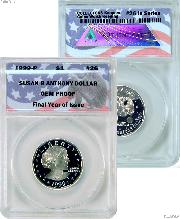
In the early 1970's the Eisenhower dollar failed to gain popularity with the public due to it's large size. As a result, treasury officials proposed replacing the Eisenhower dollar with a smaller coin. The Mint began designing the small dollar in 1976. They experimented with eight, ten, eleven and thirteen sided coins but eventually went with a round dollar to save the cost of minting as well as the cost of modifying vending machines to accept coins that were not round. The Susan B. Anthony dollar was the result of this research.
The U.S. Mint had anticipated a large public demand and struck a large quantity of the coins prior to the 1979 release. The Susan B. Anthony dollar was only slightly larger than a quarter, was struck in the same copper-nickel clad composition, and had the same reeded edge as the quarter. This resulted in the dollar being confused with the quarter and as such the Susan B. Anthony coin never gained popularity. In fact, it was disliked so much that many businesses refused to accept them. By 1981, the mint had such a large stockpile of these dollar coins that production was ceased.
Despite it's poor reception from the public, the coin became popular with vending machines and mass transit systems in the following decades. By 1997, the mint began experiencing a shortage of the coins and a decision was made to reinstate the production of small dollars. The Treasury Department proposed legislation authorizing a new design with the same size and weight so that vending machines would not need to be modified, but with a gold color and a plain edge to make it easily distinguishable from the quarter. Preparations for the new golden Sacagawea dollar proceeded slowly and the shortage grew drastic. In response, the Mint proceeded with a final run of the Susan B. Anthony dollar in 1999.
The Susan B. Anthony Dollar:
The obverse of the coin was designed by then Chief Mint Engraver Frank Gasparro. With the help of a friend, Gasparro launched an exhaustive research project on Anthony. The design is largely based on two images of her but he references six. Gasparro created many designs prior to gaining acceptance. One depicting Anthony at age 28 was classified as unnecessarily too pretty by Anthony's great-niece. She regarded another, depicting Anthony at age 84, as too old. In the end, Gasparro attempted to depict her at age 50, right in the middle of her time as a social reformer. Unfortunately there were no photographs of her from that time so Gasparro had to guess. After some more modifications, the design was approved and has been generally accepted as an accurate depiction.
Gasparro also designed a reverse for the coin, featuring an eagle flying above a mountain against the rising sun, but the Senate amended the bill to maintain the Apollo 11 design used on the Eisenhower dollar.